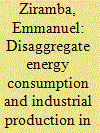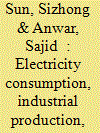|
|
|
Sort Order |
|
|
|
Items / Page
|
|
|
|
|
|
|
| Srl | Item |
| 1 |
ID:
088219


|
|
|
|
|
| Publication |
2009.
|
| Summary/Abstract |
This paper tries to assess the relationship between disaggregate energy consumption and industrial output in South Africa by undertaking a cointegration analysis using annual data from 1980 to 2005. We also investigate the causal relationships between the various disaggregate forms of energy consumption and industrial production. Our results imply that industrial production and employment are long-run forcing variables for electricity consumption. Applying the [Toda, H.Y., Yamamoto, T., 1995. Statistical inference in vector autoregressions with possibly integrated processes. Journal of Econometrics 66, 225-250] technique to Granger-causality, we find bi-directional causality between oil consumption and industrial production. For the other forms of energy consumption, there is evidence in support of the energy neutrality hypothesis. There is also evidence of causality between employment and electricity consumption as well as coal consumption causing employment.
|
|
|
|
|
|
|
|
|
|
|
|
|
|
|
|
| 2 |
ID:
137704


|
|
|
|
|
| Summary/Abstract |
Within the context of a tri-variate vector autoregressive framework that includes entrepreneurship, this paper examines the link between electricity consumption and industrial production in Singapore's manufacturing sector. Unlike the existing studies, this paper focuses on one sector of the economy and utilises a unique monthly dataset. Empirical analysis based on Johansen's cointegration approach shows that the three variables are cointegrated – i.e., a stable long-run relationship exists among electricity consumption, output and entrepreneurship in Singapore's manufacturing sector. Empirical analysis based on data from January 1983 to February 2014 reveals that electricity consumption adjusts very slowly to shocks to industrial production and entrepreneurship. Furthermore, entrepreneurship Granger causes electricity consumption, which causes industrial production. As electricity consumption causes industrial output, the growth hypothesis concerning energy consumption and economic growth holds in Singapore's manufacturing sector and policies that restrict electricity production, without electricity imports, are likely to lead to a decline in the manufacturing output.
|
|
|
|
|
|
|
|
|
|
|
|
|
|
|
|
| 3 |
ID:
105780


|
|
|
|
|
| Publication |
2011.
|
| Summary/Abstract |
In this paper, the relationship between per capita CO2 emissions and the share of industrial value added in gross domestic product (GDP) for the G-7 countries is discussed using a novel approach. It is assumed that per capita CO2 emissions are correspondent to the share of industrial value added in GDP. A model is developed using hidden Markov process to search this initial assumption. In the model, the data for industrial share in GDP are assigned to be the observations, while the data for per capita CO2 emissions represent the hidden process, which may be then predicted using the ratio of industrial value added to GDP. The data set covers the period from 1970 to 2008 and the model is tested for the G-7 countries. The study findings show that, except in the case of Canada, the hidden Markov model performs reasonably well in tracking per capita CO2 emissions. The study results provide also a basis for a number of policy implications.
|
|
|
|
|
|
|
|
|
|
|
|
|
|
|
|
| 4 |
ID:
133728


|
|
|
|
|
| Publication |
2014.
|
| Summary/Abstract |
This article discusses the visions and practices of DIY (do-it-yourself) maker culture in China. It analyses how the ideals held by DIY makers, such as openness, peer production, and individual empowerment, are formulated in relation to China's project of building a creative society and economy. To demonstrate, this article draws from long-term ethnographic research, including the setting up of China's first hackerspace, the proliferation of making, and partnerships between makers and manufacturers. China's makers are driven to reinvent what creativity, innovation, industrial production and citizenship mean today, simultaneously exploiting and challenging political rhetoric. By setting up hackerspaces, designing open technologies and starting up businesses, they craft alternative subject positions, for themselves and others. The contribution of this article is threefold. First, it fills a gap in current research by providing an account of a culture of technology production. Second, it proposes the analytical lens of 'making subjectivities' to open up the concept of the netizen, illustrating the importance for Chinese Internet research to consider not only technology use, but also the culture and materials of its production. Third, it demonstrates that maker culture is better understood as a parasitic culture rather than a counterculture, altering the system from within, contributing to our understanding of the relationship between technology use, production, society, activism and the state.
|
|
|
|
|
|
|
|
|
|
|
|
|
|
|
|
| 5 |
ID:
185932


|
|
|
|
|
| Summary/Abstract |
As the first basic law of the People’s Republic of China (PRC), the launching of the Marriage Law on May 1, 1950, was the Chinese Communist Party’s (CCP) attempt to construct institutionalized and standardized criteria for social governance. However, tension between official reports and internal, confidential documents suggests that the implementation of the Marriage Law in Northeast China in the early 1950s confronted a series of difficulties. Due to the geographical and geopolitical distinctiveness of the region, the two priorities of the Northeast Bureau were the construction of heavy industry and support of the military during the Korean War (1950–1953). Within this context, frustrations with the Marriage Law were not simply a result of stubborn traditional opinions but reflected a conflict between different dimensions of modernity. Drafted before the founding of the PRC, the Marriage Law was representative of the party’s legislative project on women’s liberation, but local experiences eventually led to the Northeast Bureau’s pragmatic operation on women’s roles in the socialist regime. Under the varying forces constantly vying for control of women’s bodies, the liberation of Chinese women was not so much the purpose as a means of achieving the CCP’s project of nation-building.
|
|
|
|
|
|
|
|
|
|
|
|
|
|
|
|
|
|
|
|
|